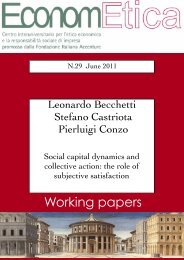WP15 November 2009 - Econometica
WP15 November 2009 - Econometica
WP15 November 2009 - Econometica
You also want an ePaper? Increase the reach of your titles
YUMPU automatically turns print PDFs into web optimized ePapers that Google loves.
A growing experimental literature on other regarding behavior shows that the probability of<br />
observing deviations from pure self-interest increases as the distance among subjects decreases.<br />
According to some authors this evidence can be explained in terms of a negative correlation<br />
between the social distance and the degree of empathy among subjects (Bohnet and Frey 1999a,b).<br />
An alternative explanation is based on the idea that the reduction of the social distance among the<br />
subjects allows for a social norm of cooperation or fairness to become effective (Roth 1995,<br />
Hoffman, McCabe and Smith 1996, Bohnet and Frey 1999a). Manipulations of social distance<br />
include: face to face interaction (Isaac and Walker 1991, Ladyard 1995, Buchan, Croson and<br />
Johnson 2006), impersonal communication (Frohlich and Oppenheimer 1998), silent identification<br />
(Bohnet and Frey 1999b and Scharlemann et al. 2001), information about personal characteristics<br />
(Charness, Haruvy and Sonsino, 2007; Charness and Gneezy, 2008), and manipulation of language<br />
(Hoffman, McCabe and Smith 1996).<br />
Our analysis differs from these approaches in two respects. First, in our experiment anonymity<br />
is removed after the game, without introducing any form of pre-play communication. Second, the<br />
reduction of social distance has never been used in the Travelers’ Dilemma, a game characterized<br />
by the property of strong interdependence and particularly capable of prompting the we-frame.<br />
Our aim is to understand if also in a setting which seems to have all the characteristics to<br />
stimulate the we-frame because of its payoff structure, the reduction of social distance increases the<br />
probability that we-frame comes to mind of players.<br />
3. Experimental Design and Procedure<br />
The experiment is based on a two-player Traveler’s Dilemma in which each player is asked to<br />
choose a number between 20 and 200 and the size of the penalty or reward is 20. 5 Let us call n 1 and<br />
n 2 the numbers chosen by player 1 and player 2 respectively. Following the standard game rules, if<br />
n 1 = n 2 , both players receive n 1 tokens (1 token = 0.05 euro); if n 1 > n 2 , player 1 receives n 2 -20<br />
5 The instructions of the experiment are available from the authors upon request.<br />
9



